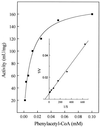Novel type of ADP-forming acetyl coenzyme A synthetase in hyperthermophilic archaea: heterologous expression and characterization of isoenzymes from the sulfate reducer Archaeoglobus fulgidus and the methanogen Methanococcus jannaschii
- PMID: 11790732
- PMCID: PMC139507
- DOI: 10.1128/JB.184.3.636-644.2002
Novel type of ADP-forming acetyl coenzyme A synthetase in hyperthermophilic archaea: heterologous expression and characterization of isoenzymes from the sulfate reducer Archaeoglobus fulgidus and the methanogen Methanococcus jannaschii
Abstract
Acetyl coenzyme A (CoA) synthetase (ADP forming) (ACD) represents a novel enzyme of acetate formation and energy conservation (acetyl-CoA + ADP + P(i) right harpoon over left harpoon acetate + ATP + CoA) in Archaea and eukaryotic protists. The only characterized ACD in archaea, two isoenzymes from the hyperthermophile Pyrococcus furiosus, constitute 145-kDa heterotetramers (alpha(2), beta(2)). The coding genes for the alpha and beta subunits are located at different sites in the P. furiosus chromosome. Based on significant sequence similarity of the P. furiosus genes, five open reading frames (ORFs) encoding putative ACD were identified in the genome of the hyperthermophilic sulfate-reducing archaeon Archaeoglobus fulgidus and one ORF was identified in the hyperthermophilic methanogen Methanococcus jannaschii. The ORFs constitute fusions of the homologous P. furiosus genes encoding the alpha and beta subunits. Two ORFs, AF1211 and AF1938, of A. fulgidus and ORF MJ0590 of M. jannaschii were cloned and functionally overexpressed in Escherichia coli. The purified recombinant proteins were characterized as distinctive isoenzymes of ACD with different substrate specificities. In contrast to the Pyrococcus ACD, the ACDs of Archaeoglobus and Methanococcus constitute homodimers of about 140 kDa composed of two identical 70-kDa subunits, which represent fusions of the homologous P. furiosus alpha and beta subunits in an alphabeta (AF1211 and MJ0590) or betaalpha (AF1938) orientation. The data indicate that A. fulgidus and M. jannaschii contains a novel type of ADP-forming acetyl-CoA synthetase in Archaea, in which the subunit polypeptides and their coding genes are fused.
Figures









Similar articles
-
Acetyl coenzyme A synthetase (ADP forming) from the hyperthermophilic Archaeon pyrococcus furiosus: identification, cloning, separate expression of the encoding genes, acdAI and acdBI, in Escherichia coli, and in vitro reconstitution of the active heterotetrameric enzyme from its recombinant subunits.J Bacteriol. 1999 Sep;181(18):5885-8. doi: 10.1128/JB.181.18.5885-5888.1999. J Bacteriol. 1999. PMID: 10482538 Free PMC article.
-
Purification and properties of acetyl-CoA synthetase (ADP-forming), an archaeal enzyme of acetate formation and ATP synthesis, from the hyperthermophile Pyrococcus furiosus.Eur J Biochem. 1997 Mar 1;244(2):561-7. doi: 10.1111/j.1432-1033.1997.00561.x. Eur J Biochem. 1997. PMID: 9119024
-
Purification and characterization of two reversible and ADP-dependent acetyl coenzyme A synthetases from the hyperthermophilic archaeon Pyrococcus furiosus.J Bacteriol. 1996 Oct;178(20):5897-903. doi: 10.1128/jb.178.20.5897-5903.1996. J Bacteriol. 1996. PMID: 8830684 Free PMC article.
-
The serine, threonine, and/or tyrosine-specific protein kinases and protein phosphatases of prokaryotic organisms: a family portrait.FEMS Microbiol Rev. 1998 Oct;22(4):229-53. doi: 10.1111/j.1574-6976.1998.tb00369.x. FEMS Microbiol Rev. 1998. PMID: 9862122 Review.
-
Conserving energy with sulfate around 100 °C--structure and mechanism of key metal enzymes in hyperthermophilic Archaeoglobus fulgidus.Metallomics. 2013 Apr;5(4):302-17. doi: 10.1039/c2mt20225e. Metallomics. 2013. PMID: 23324858 Review.
Cited by
-
Investigating the mechanism of ADP-forming acetyl-CoA synthetase from the protozoan parasite Entamoeba histolytica.FEBS Lett. 2017 Feb;591(4):603-612. doi: 10.1002/1873-3468.12573. Epub 2017 Feb 9. FEBS Lett. 2017. PMID: 28129670 Free PMC article.
-
Culexarchaeia, a novel archaeal class of anaerobic generalists inhabiting geothermal environments.ISME Commun. 2022 Sep 20;2(1):86. doi: 10.1038/s43705-022-00175-8. ISME Commun. 2022. PMID: 37938354 Free PMC article.
-
Reaction mechanism and structural model of ADP-forming Acetyl-CoA synthetase from the hyperthermophilic archaeon Pyrococcus furiosus: evidence for a second active site histidine residue.J Biol Chem. 2008 May 30;283(22):15409-18. doi: 10.1074/jbc.M710218200. Epub 2008 Mar 27. J Biol Chem. 2008. PMID: 18372246 Free PMC article.
-
Characterization of ten heterotetrameric NDP-dependent acyl-CoA synthetases of the hyperthermophilic archaeon Pyrococcus furiosus.Archaea. 2014 Feb 11;2014:176863. doi: 10.1155/2014/176863. eCollection 2014. Archaea. 2014. PMID: 24669200 Free PMC article.
-
Genomic and enzymatic evidence of acetogenesis by anaerobic methanotrophic archaea.Nat Commun. 2020 Aug 7;11(1):3941. doi: 10.1038/s41467-020-17860-8. Nat Commun. 2020. PMID: 32770005 Free PMC article.
References
-
- Adams, M. W., J. F. Holden, A. L. Menon, G. J. Schut, A. M. Grunden, C. Hou, A. M. Hutchins, F. E. Jenney, C. Kim, K. Ma, G. Pan, R. Roy, R. Sapra, S. V. Story, and M. F. Verhagen. 2001. Key role for sulfur in peptide metabolism and in regulation of three hydrogenases in the hyperthermophilic archaeon Pyrococcus furiosus. J. Bacteriol. 183:716–724. - PMC - PubMed
-
- Altschul, S. F., W. Gish, W. Miller, E. W. Myers, and D. J. Lipman. 1990. Basic local alignment search tool. J. Mol. Biol. 215:403–410. - PubMed
-
- Bradford, M. M. 1976. A rapid and sensitive method for the quantitation of microgram quantities of protein utilizing the principle of protein-dye binding. Anal. Biochem. 72:248–254. - PubMed
-
- Bult, C. J., O. White, G. J. Olsen, L. Zhou, R. D. Fleischmann, G. G. Sutton, J. A. Blake, L. M. Fitzgerald, R. A. Clayton, J. D. Gocayne, A. R. Kerlavage, B. A. Dougherty, J. F. Tomb, M. D. Adams, C. I. Reich, R. Overbeek, E. F. Kirkness, K. G. Weinstock, J. M. Merrick, A. Glodek, J. L. Scott, N. S. M. Geoghagen, and J. C. Venter. 1996. Complete genome sequence of the methanogenic archaeon, Methanococcus jannaschii. Science 273:1058–1073. - PubMed
Publication types
MeSH terms
Substances
LinkOut - more resources
Full Text Sources
Other Literature Sources
Molecular Biology Databases
Research Materials
Miscellaneous

